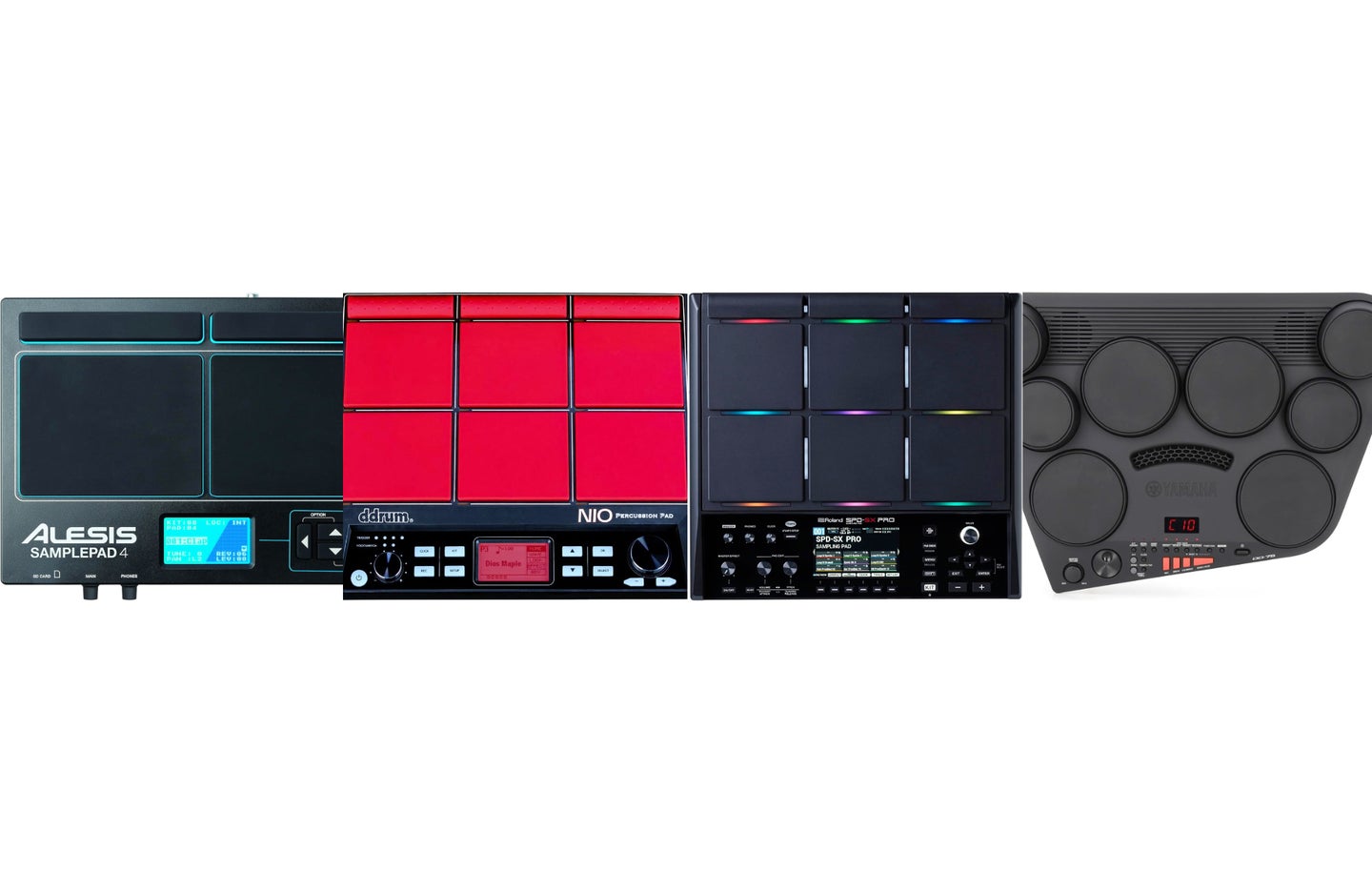
Brandt Ranj / Popular Science
Published Jan 5, 2024 4:00 PM EST
These e-drum pads pack a world of percussion sounds into a small unit drummers can play either on their own or as part of a larger hybrid drum kit.
Best overall
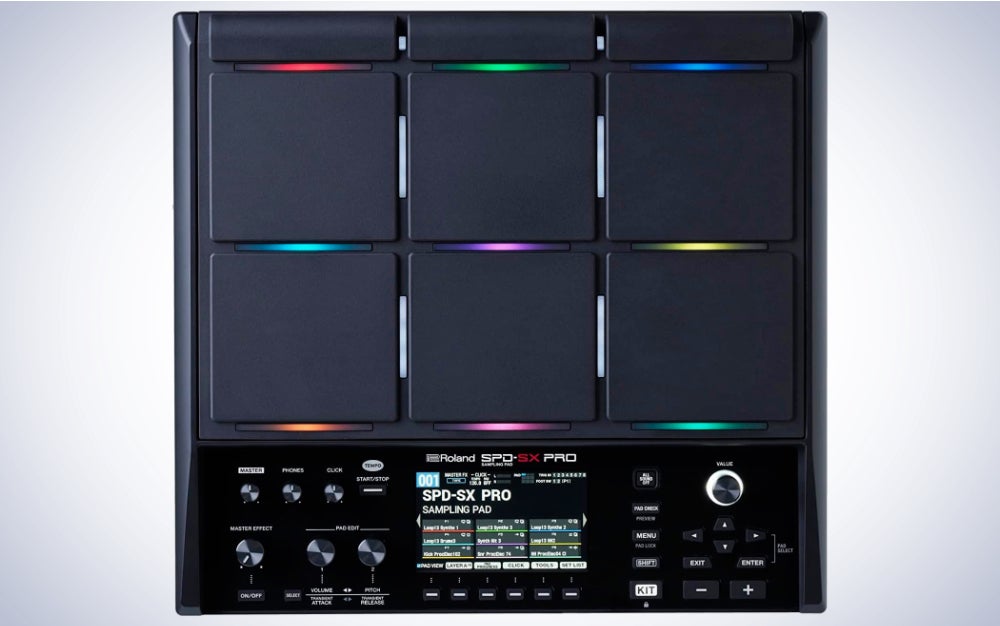
Roland SPD-SX Pro
SEE IT
Epic sounds, supreme build quality, and the highest-level performance features.
Best for beginners
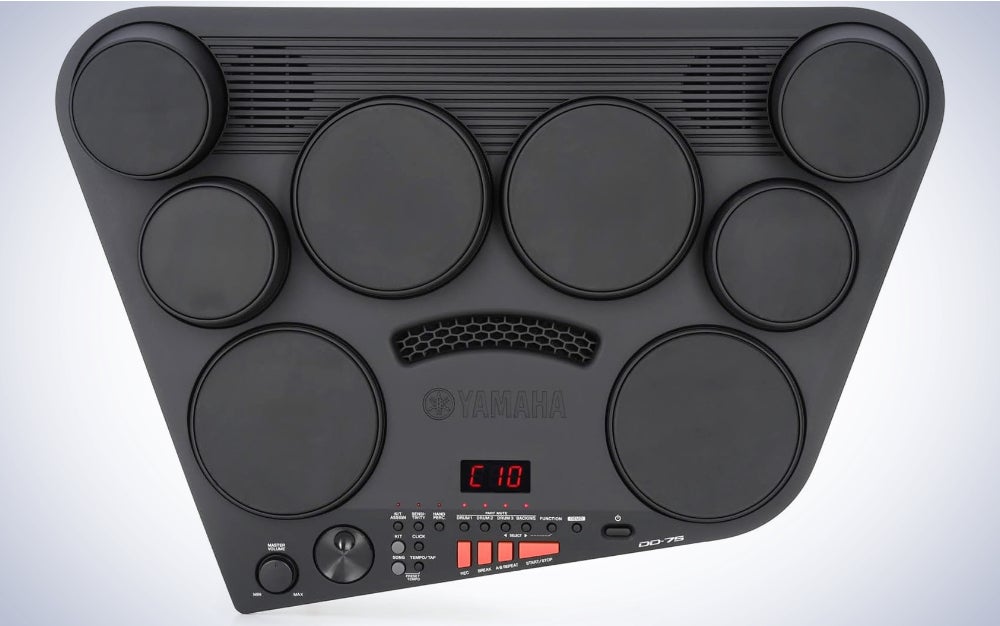
Yamaha DD-75
SEE IT
Everything a fledgling drummer needs to get started, including built-in speakers and foot pedals.
Best budget
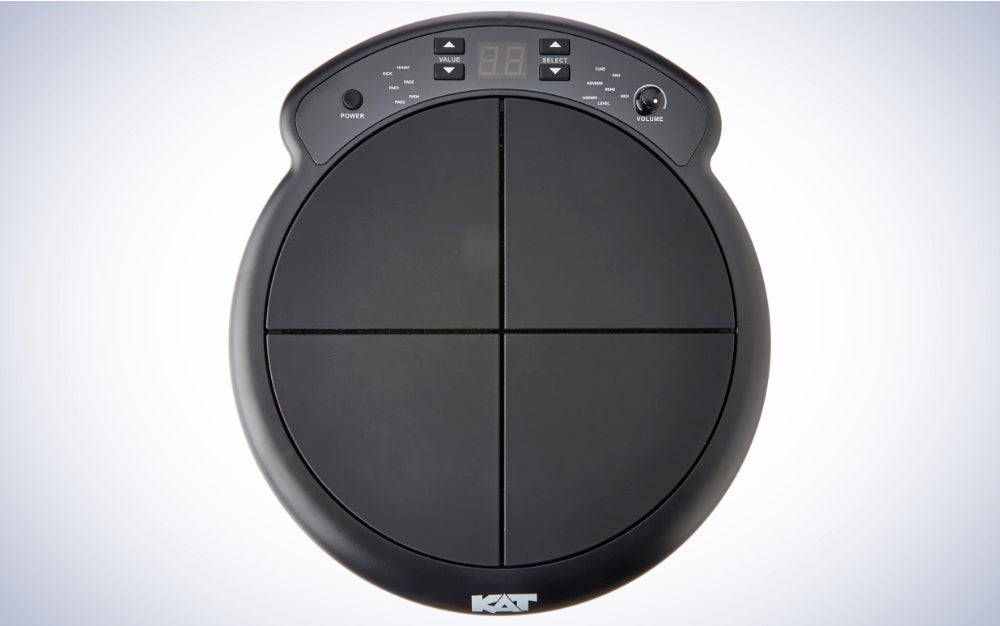
KAT Percussion KTMP1
SEE IT
Solid sounds and pads, with expandability for a low price.
Published Jan 5, 2024 4:00 PM
We may earn revenue from the products available on this page and participate in affiliate programs. Learn more ›
Whether you’re a beginning drummer armed with little more than a fancy for rhythm and a fantasy of rocking a big stage or you’re an active drummer needing some extra sounds and inspiration, electronic drum pads deliver big gifts in a small package. They let you simulate the effect of playing an entire drum kit on a single portable unit, often with hundreds of amazing electronic and acoustic drum, percussion, and melodic sounds. Electronic drum pads let you practice your skills in a small space or add some huge electronic flare to an acoustic drum set. Most of them also easily integrate with computer music production software over USB. Performance drum set add-ons, standalone mini kits, or both: These are the best electronic drum pads.
Best overall: Roland SPD-SX Pro
Best value: ddrum Nio
Best for beginners: Yamaha DD-75
Best compact: Alesis SamplePad 4
Best set: Roland TD-02K
Best budget: KAT Percussion KTMP1
How we chose the best electronic drum pads
To select the best electronic drum pads of 2024, we scoured every option, from budget-priced to the highest-end pro options and from the biggest names in the industry to smaller boutique brands. Electronic drum pad users range from beginners to professionals, each with varying needs like at-home practice, in-studio production, and on-stage performance. These picks include great options for each use case, and many of them would work well for all three.
I have firsthand experience with many of these picks—as well as others that did not make the list—from decades of playing electronic drums and pads. Where personal experience was not a factor, we took the advisement of bandmates and other musicians, professional product reviews, online specs and videos, and user feedback.
The best electric drum pads: Reviews & Recommendations
Electronic drum pad units vary widely, from those including a single pad to ones with 10 or more pads, from those including just a handful of onboard sounds to ones with thousands. Some are made more with practice in mind, while others excel in professional recording and performance. The chosen e-drum pads here cover all the ground when it comes to size, features, and budget. They all have sounds included and a headphone jack (by listening through headphones, you won’t have to spend big money on soundproofing a home studio), so they’re plug-and-play. They also all have either included foot pedals for kick drum and hi-hat or trigger connections for adding foot pedals sold separately.
Best overall: Roland SPD-SX Pro
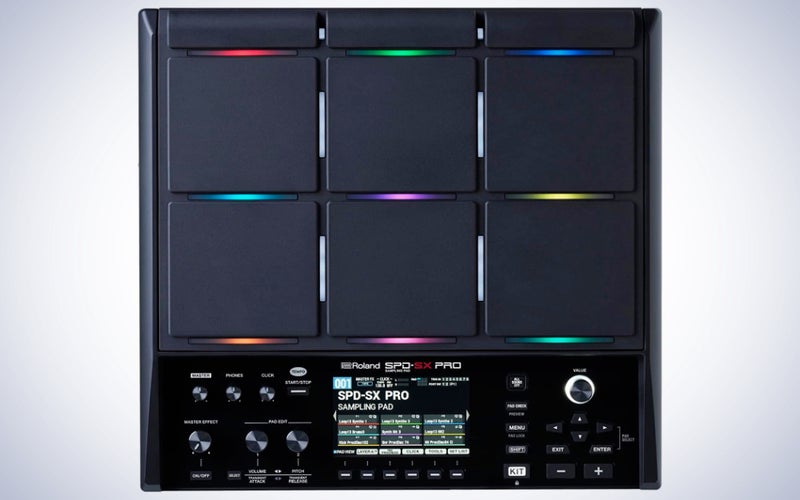
Specs
Pad configuration: 9 pads in 3 x 3 rows of square pads and edge pads
Number of sounds/storage: 1550+ sounds and 200 kits, w/32GB of audio storage
Connectivity: 1 x 1/4-inch audio input, 1 x 1/4 headphone output, 2 x 1/4-inch main audio outputs, 4 x 1/4-inch audio outputs, 6 x 1/4-inch trigger/footswitch inputs, 5-pin MIDI I/O, USB-A for storage, USB-B for computer
Pros
Huge selection and variety of sounds, kits, and effects
Outstanding build quality and pad response
Most flexible options on the market for pro drummers
Pro level, but also easy to use for beginners
Tons of audio connections and trigger ports for expanding into a mini kit
Original sample recording and editing
Cons
Extras and pro performance features come at a cost.
With the Roland SPD-SX Pro, pro/semi-pro drummers and even dedicated beginners will gain from Roland’s decades of experience making some of the finest electronic multi-pads in the industry, including the original SPD that originated over 20 years ago. The SPD-SX Pro includes everything that the popular (and still available) SPD-SX had but adds twice the audio storage (32 GB), twice the programmable kits, more audio and trigger connectivity, a 4-inch color display, programmable multi-color pad LEDs, and many new professional performance features.
For those who just want to plug and play, the SPD-SX Pro furnishes them with more than 1,550 acoustic, electronic, and melodic drum and percussion sounds, as well as 200 preset kits and effects like EQ, reverb, delay, distortion, and compression. Hands-on knobs control volume for main and headphone output and the click (metronome), as well as easy edit knobs for the volume, pitch, and attack/release length of individual sounds. The large display makes in-depth editing of sounds, kits, effects, and audio routing easier, but Roland also includes a dedicated PC/Mac software app for making editing a breeze from a computer connected over USB. Most electronic drum pads don’t include such software.
The quality and variety of the sounds and the road-worthy build quality are all excellent, yet the myriad options under the hood distinguish the SPD-SX Pro the most. A large basket of performance features lets drummers assign a sequence of sounds to play continuously from a single pad, program color LED effects, create loops, layer different sounds to the same pad, create a set list of kits, switch sounds by velocity (how hard the pad is hit), link pads together, create pad mute groups, and more. The unit can also record samples from the audio input or load and edit samples imported from the USB drive input.
All told, the Roland SPD-SX Pro offers comprehensive and high-level features whether you want a simple set of drum pads to play or a complex live performance powerhouse that can run backing tracks and send different sounds through different audio outputs. With all its trigger and pedal connections, you could expand it into its own mini e-drum kit with optional kick and high-hit pedals and extra drum and cymbal pads. Although the SPD-SX Pro’s price dwarfs that of some full electronic drum kits, you get what you pay for.
Best value: ddrum Nio
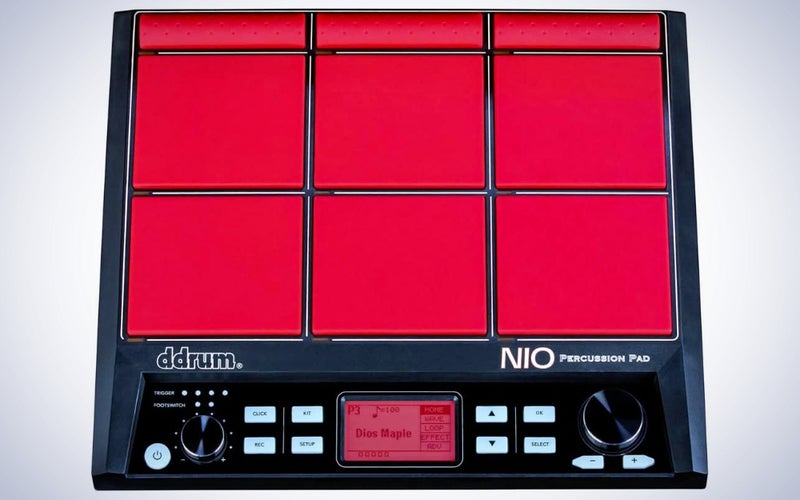
Specs
Pad configuration: 9 pads in 3 x 3 rows of square pads and edge pads
Number of sounds/storage: 608 sounds and 30 kits, w/512MB of audio storage
Connectivity: 1 x 1/8-inch audio input, 1 x 1/4 headphone output, 2 x 1/4-inch main audio outputs, 2 x 1/4-inch dual-trigger inputs, 2 x 1/4-inch footswitch inputs, 5-pin MIDI I/O, USB-A for storage drives, USB-B for computer
Pros
Diverse selection of high-quality sounds and kits
Loads of connectivity options
Ability to load your own samples over USB
Easy operation
Cons
Limited drum sound editing
No sample recording
Pads not quite as responsive as some higher-priced alternatives
The classic 3-row, 9-pad layout of electronic drum pads has made an indelible impression on drummers’ minds since the success of Roland’s SPD series. This format puts enough pads to simulate a full drum kit within a space that fits well on a desktop or on a stand when incorporated into a larger acoustic or electronic drum set—usually with a ton of great sounds and connectivity/expansion options as well. However, not everyone really needs the comprehensive professional options that drive up the cost of something like the Roland SPD-SX Pro. To grab a great 9-pad electronic drum multi-pad with all the essential basics and many pro-level options without every single pro performance feature, the ddrum Nio makes for an excellent value.
The Nio contains hundreds of sweet-sounding drum and percussion hits in 30 kits that weigh heavily on acoustic drum kits but also include several nice electronic drum kit styles (trap, drum-n-bass, hip-hop, and more) and percussion kits like Cajon, African, conga, and others. Its decent-sized display and hardware controls make it relatively painless to create your own kits with the onboard sounds or samples imported from a USB drive, and sounds can be edited with 3-band EQ, reverb, and compressor/limiter.
While the Nio does not include onboard sample recording or waveform editing of the drum sounds, it delivers big time with its connectivity options. Two dual triggers and two footswitch inputs let you build out a larger kit with optional pedals and external triggers. The 5-pin MIDI I/O and USB connections let you integrate the Nio to trigger sounds and sync tempos with computer and MIDI hardware setups. There are also separate headphone and main audio outputs and an 1/8-inch audio input for piping in your own songs or tutorial lessons to play along to. Other helpful practice features include a loop recorder and metronome.
The Nio’s pads are not quite as responsive as some high-end multi-pads, but they are very powerfully built, and the whole unit is sturdy and ready for live performance. For its reasonable price, the Nio should make a very capable electronic drumming companion for years to come.
Best for beginners: Yamaha DD-75
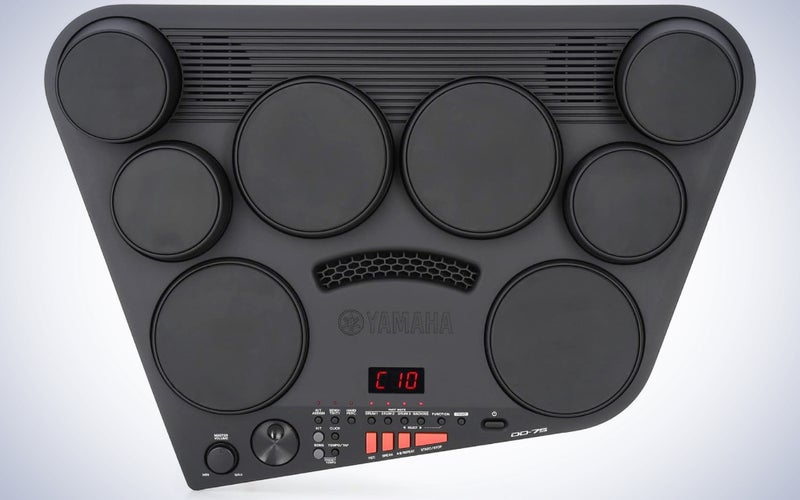
Specs
Pad configuration: 8 pads arranged like a drum set and 2-foot pedals for kick and hi-hat
Number of sounds/storage: 570 sounds and 75 kits
Connectivity: 1 x 1/8-inch aux input; 1 x 1/4-inch TRS output; 2 x 1/4-inch pedal inputs; 5-pin MIDI I/O
Pros
Can play with both sticks and hands
Many sounds come from Yamaha’s pro gear
Battery power and built-in speakers for portability
Two included foot pedals
Cons
No USB
Could use lesson modes other than play-along songs
Many electronic drum pads have trigger ports for connecting kick drum and hi-hat pedals sold separately, as well as audio outputs for hooking up to an amplifier or powered monitors. However, for a beginning drummer, the Yamaha DD-75 offers built-in speakers (as well as an audio output for headphones or speakers) and two foot pedals for controlling the bass drum and hi-hat sounds. Also, its portability makes it one of the best electronic drum sets for beginners—it can run on either the included AC adapter or six C batteries, making the DD-75 a portable mini-kit of electronic drum pads right out of the box.
Some internal songs allow drummers to play along to practice their timing, but there’s also an internal click track to practice to and an audio input for plugging in any music to play along to through the speakers or headphones. An internal 4-track recorder also makes it fun to try to layer together music from the DD-75’s selection of world percussion, acoustic, and electronic drum sounds that were made originally for high-end Yamaha synthesizers and electronic drum kits. The pads are also made to respond well to playing them either with the included sticks or your hands.
Although an all-in-one wonder for just a few hundred dollars, the DD-75 does also have 5-pin MIDI input and output, meaning you can trigger its sounds from another MIDI keyboard or use the DD-75’s pads to trigger sounds from other MIDI sound modules. However, the DD-75 does not have USB for integrating into computer music setups. But the DD-75 portable electronic drum pads have everything needed to keep a beginning drummer happy or for an experienced drummer’s at-home compact practice kit.
Best compact: Alesis SamplePad 4
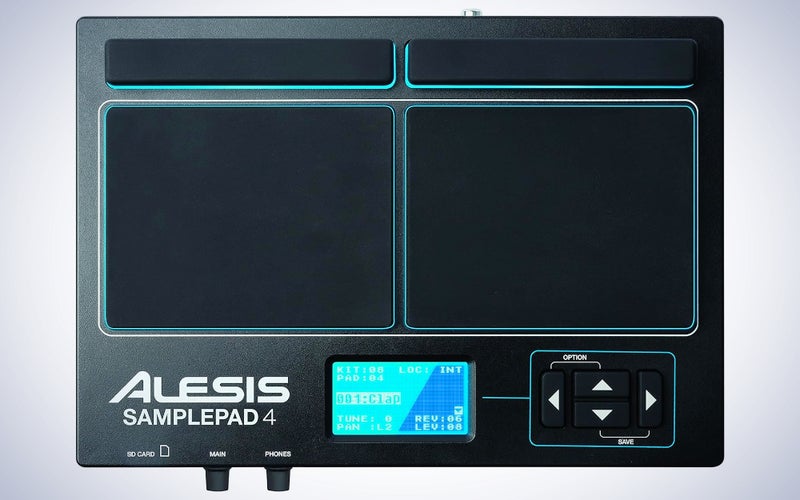
Specs
Pad configuration: 4 pads (2 large, 2 edge)
Number of sounds/storage: 25 sounds and 10 kits, w/expansion storage via SD card slot (up to 32GB)
Connectivity: 1 x 1/4-inch stereo headphone out, 2 x 1/4-inch main audio out, 1 x 1/4-inch TRS dual trigger input, USB-B for MIDI I/O, SD card drive
Pros
Compact and light, yet capable
SD card can add hundreds of sounds
Reasonably priced
Cons
USB is for MIDI transfer only, not audio
Only 25 onboard sounds
Sometimes, a practice space, bedroom, garage, etc., doesn’t have a lot of extra space, but a single trigger pad like the Roland SPD::One just won’t do. In that case, the compact Alesis SamplePad 4 steps in. At 7.5 x 10.25 inches and 2.5 pounds, it’s less than half the footprint and weight of the Roland SPD-SX Pro and other similar electronic drum multi-pads. Within that space are four pads for triggering the 25 high-quality onboard sounds. While that’s not many sounds, the SD card drive (memory card not included) can load up to 512 samples and 89 user-created kits from an SD card.
The SamplePad 4 can edit both onboard and SD card sounds by adjusting their tuning and adding reverb. It can also set individual audio level and panning (stereo left/right) settings for each sound. For expansion, the SamplePad 4 can accept up to two additional external trigger pads or pedals through its dual trigger input. Also, the USB port sends MIDI data (although not audio) to a computer, so you can use the SamplePad 4 to record realistic-sounding beats in digital audio workstation (DAW) software.
Small, yet expandable, the SamplePad 4 fits into nearly any setup, and its low price fits into tight budgets as well.
Best set: Roland TD-02K
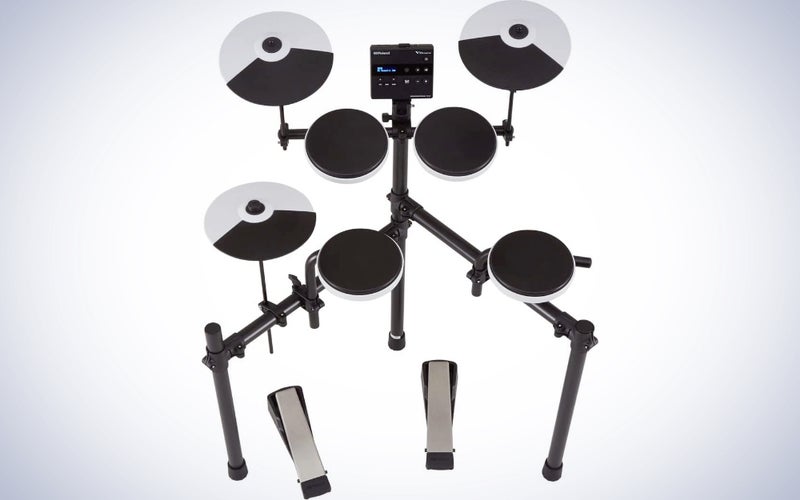
Specs
Pad configuration: 4 drum pads, 3 cymbal pads, 2 foot pedals
Number of sounds/storage: 16 unique kits
Connectivity: 1 x 1/8-inch aux input; 1 x 1/8-inch stereo output, USB Type-B for MIDI and stereo audio
Pros
Good quality full e-drum kit with compact footprint
Dual-zone cymbal pads with choking feature
Built-in Coach mode practice exercises
USB port transmits both MIDI and audio
Cons
Foot controller for the kick rather than a pedal with pad
Rack stand system not very flexible for arranging pads’ position
Most of the electronic drum pads listed here have expansion trigger ports for adding kick or hi-hat pedals or external drum or cymbal pads. That lets you expand them into a compact mini-kit. However, if a full kit is what you’re after in a set of electronic drum pads, you could have that in one go with something like the Roland TD-02K, a full e-drum kit that gives you the acclaimed sound and build quality of Roland V-Drums in an affordable package—foot pedals and cymbal pads included.
The TD-02K sets up conveniently in a small corner space on a metal rack stand and includes the TD-02 drum module, which has 16 kits spanning huge-sounding studio drums, tight and dry kits, and modern electronic drums based on recent chart-toppers. The module has an audio input for playing along to songs or tutorial videos and a USB port for connecting to a computer and recording both the MIDI data and audio output of the TD-02K module.
All four of the kit’s drum pads have refined rubber surfaces, and the two dual-zone crash cymbals also have a choking function, where you can mute a cymbal crash sound by grabbing the cymbal pad with your hand. Rather than rubber pads, many more expensive electronic drum kits use mesh heads for their drums, which more closely mimic the feel of acoustic drum heads. Roland offers a version of this kit, the TD-02KV, which is exactly like the TD-02K except it has a dual-zone mesh-head V-drum snare with adjustable tension and rim trigger for $200 more. Each version of the kit is small and sturdy enough to be picked up and moved after a practice session, making it ideal for fitting a full electronic drum pads kit into a small or crowded space.
The TD-02 module encourages practicing and steady improvement with its built-in Coach mode that dishes out lessons like Time Check, Change-Up, Quiet Count, Auto Up/Down, and more. The module also has a special slot in the back for an optional Boss Bluetooth Audio MIDI adapter, which gives the TD-02 Bluetooth connectivity for audio and MIDI when purchased separately.
Best budget: KAT Percussion KTMP1
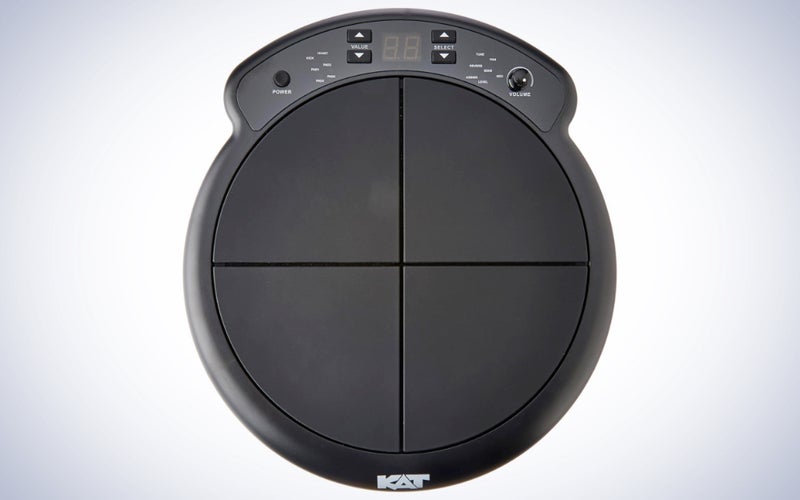
Specs
Pad configuration: 4
Number of sounds/storage: 50 drum and percussion sounds
Connectivity: HDMI 2.1 input x3, HDMI 2.1 eARC output x1, optical digital
Pros
Low price and small footprint
MIDI out and USB for incorporating into larger setups
Kick and hi-hat trigger inputs for expansion
Well built for its cost
Cons
No preset or savable kits
Pads are less responsive than more expensive options
If budget is your chief concern when shopping for electronic drum pads, there are many low-priced—and shoddily made—options you could find online that we don’t recommend you buy. What good is “saving” money if your purchase doesn’t work in a month? Instead of falling for the promises of lousy gear that will soon end up in a landfill, consider an option that, while not perfect, is made to last and offers a complement of high-level features: the KAT Percussion KTMP1.
For about a hundred dollars, the KTMP1 provides 50 diverse drum and percussion sounds and four pads in a circular arrangement that doesn’t take up much more surface area than a non-electronic practice pad. The sounds range from acoustic and electronic bass drums, snares, toms, cymbals, and percussion sounds like tambourine, cowbell, conga, tabla, and more. Unfortunately, there are no kits to scroll through, but you can select any sound you want for each pad with the hardware buttons and basic two-digit display.
The KTMP1 also integrates nicely into larger setups with a MIDI out and USB connection for playing sounds from other MIDI modules or virtual instruments and samples from computer software. Two trigger jacks for a hi-hat controller and kick drum pedal—such as the KAT KT-HC1, KAT KT-KP1, or other third-party options—let you expand the pads into a mini drum set. The KTMP1 does not have that many onboard sounds, but the simple menu does allow you to set the tuning, panning, level, and reverb amount for each sound. In the end, the KTMP1 presents an affordable electronic drum pad option with enough capability to be useful for practice, performance, and music production.
There are many factors to weigh when deciding which electronic drum pads are best for you. Below are the ones we considered most important when making our recommendations:
Goals, skill level, and/or commitment
Some people are basically born to drum, and others have an interest in drumming but don’t believe they could ever do it. Electronic drum pads can be a good avenue to explore an interest in drumming without committing a huge amount of money and room in your living space. You can use them to practice along to video lessons or your favorite songs and then find out if you want to take the practice further with a larger drum kit or with additional trigger pads, cymbal pads, and pedals that plug into your electronic drum pads.
Your plans to just practice at home for fun or to use your electronic drum pads to perform live, either solo or in a band, can inform you of the level of features and options you need. Most electronic drum pads can connect to a computer and include some software and/or can add kick and hi-hat pedals plus other triggers to build an electronic drum pad unit into a formidable practice or performance kit.
Other high-level features that more casual users could probably do without include the ability to record samples from external audio or microphone inputs, high-level sound editing, and sound effects. The most professionally equipped electronic drum pads may include specialized live performance features meant for triggering a band’s backing tracks from the pads, creating set lists of drum kits for quick switching between songs, and so on. Weighing your current needs against your future goals for using your electronic drum pads will inform how sophisticated a unit will be best for you.
Budget
The electronic drum pads listed here range from about $100 to $1,100, and that price range represents a range in build quality, onboard sounds, connectivity, internal menu options, and more. You won’t always be able to satisfy any budget if you have the highest demands for an electronic drum pads unit. However, there are usually at least some options. For example, the closest thing to the comprehensive capability of the Roland SPD-SX Pro is probably the Alesis Strike Multipad, which approximates much of the capabilities at a significantly lower price.
When figuring out your budget, remember that if you don’t have them already, you may need drum sticks, a stand for the electronic drum pads, plus expansion foot pedals and trigger pads if you want them. Those extras could easily add another few hundred dollars to your total.
Will it be part of a larger drum set or a standalone?
Many drummers like to add an electronic drum pad to their acoustic kit as a way of incorporating a wide variety of additional sounds to their setup without having to add a large amount of extra gear. If that’s the case for you, any of the options in this guide could work for you, and it just depends on how many pads and sounds you want. Or you may want to look at the popular Roland SPD-One series, which are super-compact single pads with tank-like build quality (such as the SPD-1P percussion pad). They cost a fair amount for a single pad, but they are made for the rigors of the road.
If, on the other hand, you want your electronic drum pads to serve as a standalone unit for playing like they’re a full drum kit, the Yamaha DD-75 is a very self-contained unit that includes its own foot pedals. Many other electronic drum pads can be expanded into mini drum kits by adding foot pedals and additional trigger pads or cymbals. The units with most connectivity for expansion are usually the 9-pad multi-pads like the Roland SPD-SX Pro and ddrum Nio. But even the small, budget options like the KAT Percussion KTMP1 have connectors for optional kick drum and hi-hat triggers.
Will you use it to record and produce music?
If you plan to or think you may use your electronic drum pads for recording music into computer software or integrating them into a larger hardware MIDI setup, you’ll want a unit with 5-pin MIDI connections and/or a USB port for a computer.
The USB ports allow you to connect the electronic drum pads to computer software to play sounds from virtual instruments and record beats as MIDI notes from those instruments. Some but not all of the USB connections will also let you record the audio output of the electronic drum pads, so you can record yourself playing beats from the onboard sounds. If that’s something you want, check before buying that the USB port transmits audio, not just MIDI.
FAQs
Q: Do electronic drums sound like real drums?
Electronic drums can sound like real drums because most electronic drums derive their sounds from samples—short recordings of acoustic drums. (A few electronic drum pads like the Nord Modeling Percussion Synthesizer produce drum sounds from synthesis rather than samples and don’t sound like real acoustic drums, offering alternatives for sound design.) Older electronic drums had very low recording quality for their samples, so they did not sound very realistic. However, today’s electronic drum pads and kits generally use very high-resolution, high-quality samples, and many of them use multiple sample layers per pad so that the sound adjusts to how hard you hit the pad.
Sample-based electronic drum pads and kits won’t sound exactly like real acoustic drums, but they get very close.
Q: What is a good-sized drum practice pad?
A good-sized drum practice pad approximates the average size of the most commonly hit acoustic drum, the snare drum. The most common sizes of snare drums are 14 and 8 inches in diameter. However, for a practice pad, 10 inches is plenty. Electronic drum pads are often even smaller than that, which can also be good for practice to enforce the good habit of hitting a drum pad or drum head very close to the same place every time (in order to get a consistent sound). You could combine a drum practice pad with an electronic drum pad using the Keith McMillen BopPad, a 10-inch drum pad that connects over USB-C to a computer or mobile device to trigger sounds. The BopPad can play a single sound from the entire pad or be split into four zones to trigger different sounds.
Q: Do professionals use electronic drums?
Yes, professional drummers use electronic drum kits, as well as electronic drum pads. Actually, professionals use electronic drum pads like the Roland SPD-SX Pro as a supplement to their acoustic drums much more often than they use electronic drum kits onstage. However, superstar music producer (Nirvana, Smashing Pumpkins, Foo Fighters) and drummer garbage Butch Vig says that playing electronic drums live can help to keep the sound pure and make it easier to control the drums’ dynamics.
So whether you play a full electronic drum kit or use a smaller unit of electronic drum pads to complement acoustic drums, know that you are in good company among professional drummers.
Final thoughts on the best electronic drum pads
Best overall: Roland SPD-SX Pro
Best value: ddrum Nio
Best for beginners: Yamaha DD-75
Best compact: Alesis SamplePad 4
Best set: Roland TD-02K
Best budget: KAT Percussion KTMP1
All of these electronic drum pads would make wonderful additions to a music studio or a performing drummer’s hybrid acoustic/electronic rig, and they could all be suitable as entry points to drumming for a beginner. However, purchasing one without fully weighing the options against your personal needs could lead to buyer’s remorse.
To avoid that, consider how many pads and internal sounds you want and whether you need USB connectivity for MIDI and/or audio. If you want to play the pad unit with your feet as well, make sure it has either included foot pedals (Yamaha DD-75 or the full Roland TD-02K kit) or enough trigger connections to add a kick drum and hi-hat pedal, such as the ddrum Nio. Finally, if you need high-level options like the ability to record your own samples and make performance set lists of drum kits, you’ll probably have to shell out for one of the more expensive high-end options like the Roland SPD-SX Pro.
Why trust us
Popular Science started writing about technology more than 150 years ago. There was no such thing as “gadget writing” when we published our first issue in 1872, but if there was, our mission to demystify the world of innovation for everyday readers means we would have been all over it. Here in the present, PopSci is fully committed to helping readers navigate the increasingly intimidating array of devices on the market right now.
Our writers and editors have combined decades of experience covering and reviewing consumer electronics. We each have our own obsessive specialties—from high-end audio to video games to cameras and beyond—but when we’re reviewing devices outside of our immediate wheelhouses, we do our best to seek out trustworthy voices and opinions to help guide people to the very best recommendations. We know we don’t know everything, but we’re excited to live through the analysis paralysis that internet shopping can spur so readers don’t have to.

>>> Read full article>>>
Copyright for syndicated content belongs to the linked Source : Popular Science – https://www.popsci.com/gear/best-electronic-drum-pads/










